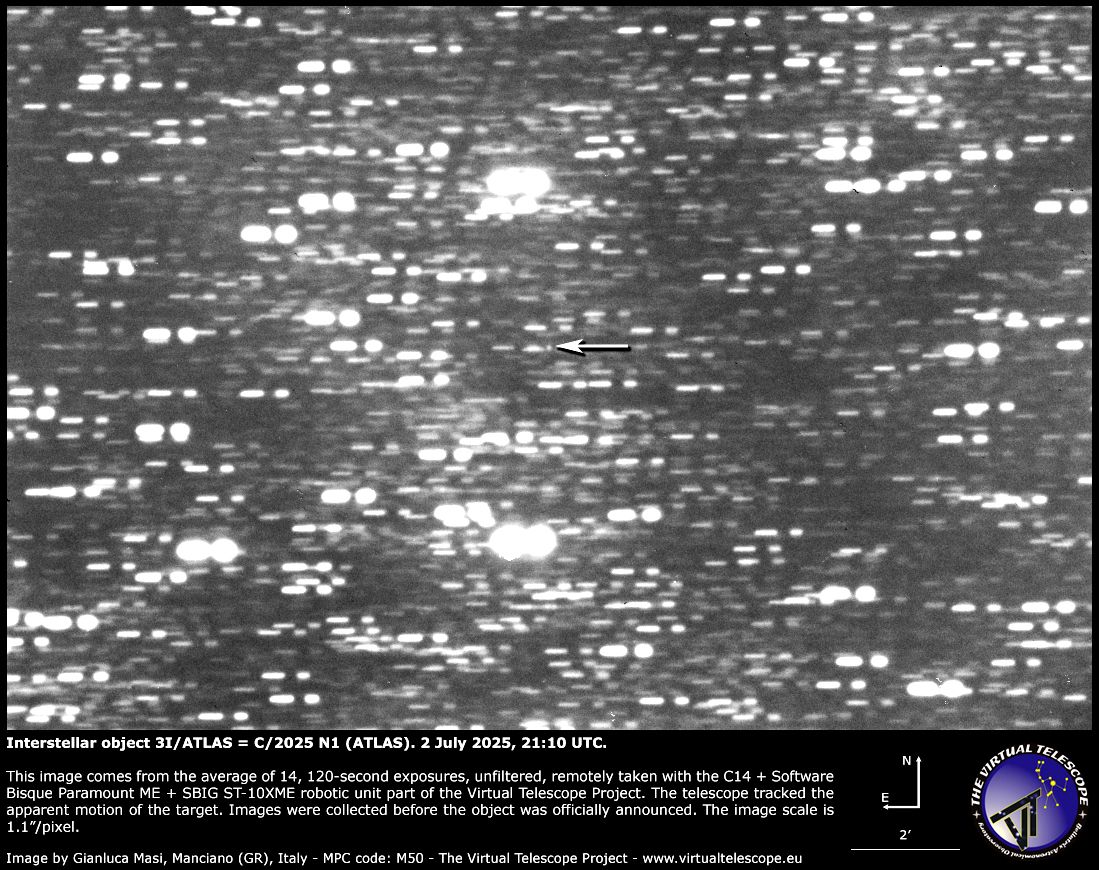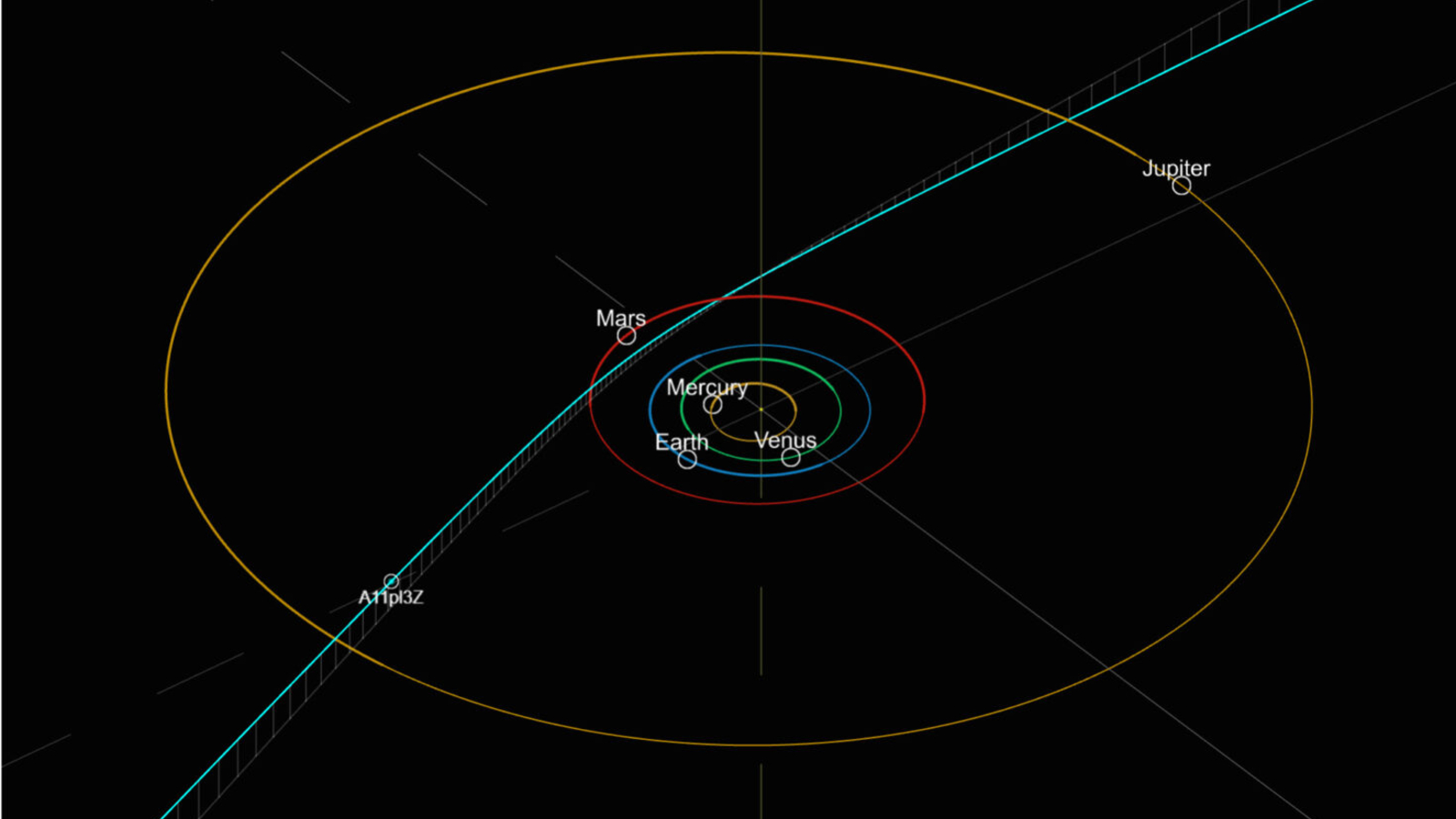Watch newly discovered 'interstellar visitor' 3I/ATLAS shoot toward us in first livestream
You can see the recently identified "interstellar object" 3I/ATLAS shooting towards us through the solar system in a livestream from the Virtual Telescope Project.

A mysterious, uninvited guest has been spotted shooting through the solar system at breakneck speed. And, for the first time, you can now see this interstellar visitor barreling towards us for yourself — thanks to a free livestream from the Virtual Telescope Project.
The newly discovered interloper, initially dubbed A11pl3Z, was revealed to us on Tuesday (July 1), when researchers spotted it in data collected by the Asteroid Terrestrial-impact Last Alert System (ATLAS), which automatically scans the night sky using telescopes in Hawaii, Chile and South Africa.
The mysterious object is traveling toward the sun at around 152,000 mph (245,000 km/h), and it is set on a very flat and straight trajectory, unlike any other known object in our solar system.
Many experts initially predicted that it was an interstellar object, meaning it originates from beyond the sun's gravitational influence and has enough momentum to shoot straight through our cosmic neighborhood without slowing down. On Wednesday (July 2), NASA confirmed this and revealed that the interloper is most likely a comet. It has now been officially named 3I/ATLAS.
The extrasolar entity is too faint to be visible to the naked eye or through amateur stargazing equipment, although it may brighten sufficiently to become visible to backyard telescopes in the coming weeks and months. However, the upcoming livestream from the Virtual Telescope Project (VTP) will share the view from VTP's powerful telescope in Manciano, Italy.
The livestream was recorded on July 3 and can be viewed on the VTP's YouTube channel.
Get the world’s most fascinating discoveries delivered straight to your inbox.

Only two other confirmed interstellar visitors have ever been spotted before now: Comet 2I/Borisov, which was seen shooting through the solar system in 2019; and 'Oumuamua, a cigar-shaped object that made headlines in 2017 when some astronomers argued it was potentially an alien probe, before experts showed it was most likely a hydrogen-spewing space rock. However, scientists suspect that many more interstellar interlopers likely pass through our cosmic neighborhood undetected.
3I/ATLAS is believed to measure up to 12 miles (20 kilometers) across and is currently around 4.5 times as far from the sun as Earth is. It will reach its closest point to the sun, known as perihelion, on Oct. 30, coming within 1.4 Earth-sun distances, or astronomical units (AU), of our home star. Shortly before this happens, the comet will also make its closest approach to Mars, coming within 0.4 AU of the Red Planet.
Earth will be on the opposite side of the sun to 3I/ATLAS during the comet's solar flyby. The object will likely make its closest approach to Earth in December, on its journey back out of the solar system. As a result, "the comet poses no threat to Earth and will remain at a [minimum] distance of at least 1.6 astronomical units," NASA officials wrote in a statement.

Astronomers are now racing to learn more about the rare object before it leaves the solar system at some point next year. Researchers will be able to study it until the end of September, when it will become obscured by the sun's light, and again from December, when the comet reemerges from behind our home star.
The interstellar visitor will likely be imaged by the Vera C. Rubin Observatory — the world's most powerful optical telescope, which recently released its first images.
Some researchers have also suggested using the James Webb Space Telescope and NASA's Mars rovers to photograph the object as it shoots toward the sun.

Harry is a U.K.-based senior staff writer at Live Science. He studied marine biology at the University of Exeter before training to become a journalist. He covers a wide range of topics including space exploration, planetary science, space weather, climate change, animal behavior and paleontology. His recent work on the solar maximum won "best space submission" at the 2024 Aerospace Media Awards and was shortlisted in the "top scoop" category at the NCTJ Awards for Excellence in 2023. He also writes Live Science's weekly Earth from space series.
You must confirm your public display name before commenting
Please logout and then login again, you will then be prompted to enter your display name.


